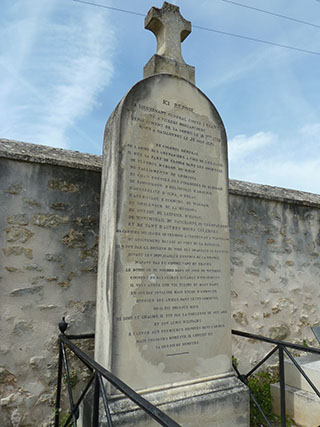Prochain point :
Place principale avec commerces, mairie, fontaine
Prochain point : lat="49.0354" lon="1.86663"

Cemetery
Some famous people are buried here
A displaced cemetery...
Until the mid-nineteenth century, the dead were buried around the church. The royal decree of December 6, 1843 obliged rural municipalities to transfer the graves outside the village due to lack of space and hygiene theories seeking to curb cholera and poor sanitation. In August 1858 a new terrain was selected at one of the highest points of the town, facing west and downwind. The old graves were transferred between 1869 and 1887.
... with some atypical graves
At the top of the cemetery, the grave of Choppin family consists of a single vault. Lords of Seraincourt from 1690 and owners of the Château de Rueil for over two centuries, the family included a squire, a king's adviser, a lawyer in the Parliament of Paris, a judge, a priest and military men. In the nineteenth century, two members of the family were mayors of Seraincourt. In 1976, the last descendant granted the town the right to use his coat of arms as the municipal emblem.
The grave of Louis Friant (1758-1829), General of the First Empire and owner of the Château de Gaillonnet, stands against the wall of the cemetery. Engaged in the French guards in 1781, his brilliant military career is recounted on the epitaph engraved on his tomb. He participated in all of Napoleon’s campaigns. His name is inscribed on the Arc de Triomphe in Paris, and the Temple of Isis at Philae (Egypt). After being wounded in the battles of Fleurus and Waterloo, he retired to Gaillonnet Priory until his death in 1829.





